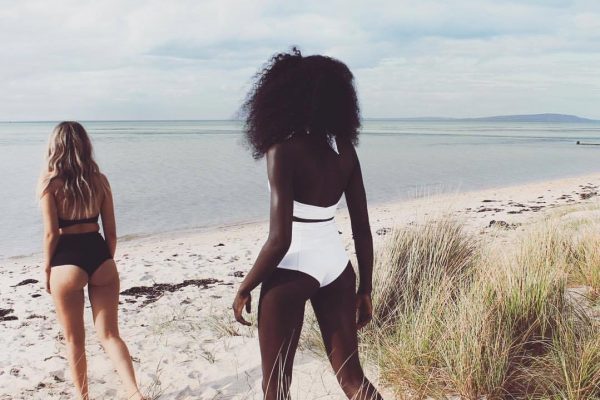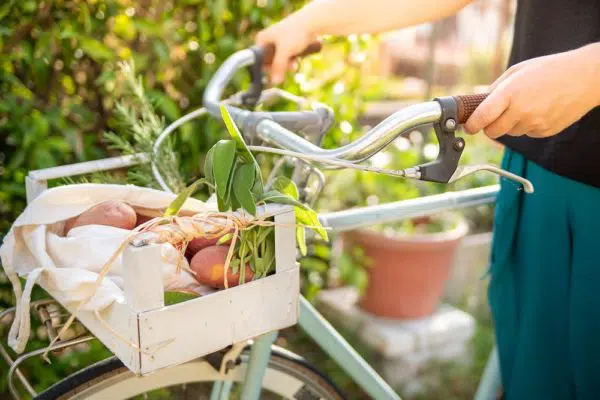The words ethical and sustainable are thrown around a lot often in the fashion industry and when we’re looking for guidance about how to be a more ethical and sustainable shopper, it’s hard to know what’s right or wrong.
It’s also important to note, the ethics around what we wear are a very personal choice and what I deem to be ethical and sustainable will not be exactly the same for you.
We often aren’t told where our purchases are made, whether the material has been sustainably sourced, what conditions the people who made it work in, what happens in the environment when we wash or dispose of it.

Being informed is the first step to making better choices.
Choices become habits and habits become behaviour. Changing our behaviour and the way we think about what we consume are the first things we can do to minimise harm to the world we live in.
The are the basic values I try and stay true to when building my sustainable wardrobe.
1. Embrace op-shopping
Buying new is not always my first choice. My wardrobe is made up of about half new and half second hand items. Ebay is my go to for pre-loved gems and I’ve found some fantastic bargains over the years. When I’m buying pre-loved fashion, I prefer Ebay and online stores such as Revoir and The Real Real, because when I buy a new item of clothing. I usually have a clear idea of what I want to add value to my existing wardrobe, and I like being able to search for exactly what I want. Some tips for second hand shopping online. Look for labels you are familiar with so you have a good idea of the quality and size. Only buy items that have good, clear descriptions and images and don’t buy something just because it’s a bargain! If you won’t wear it then it’s a waste. For physical stores, check out our op shopping tips with eco stylist Faye De Lanty.
2. Check certifications
Most ethical brands will have third party certifications which verify their clothing is being made under fair and ethical conditions. Fortunately we live in the digital age and accessing information about our clothes is becoming easier every day, there are even apps to help you make better purchasing decisions on the go.
- Ethical Clothing Australia is “an accreditation body working collaboratively with local textile, clothing and footwear (TCF) companies to ensure their Australian supply chains are transparent and legally compliant”. They have a list of accredited brands which can be found on their site.
- Good On You is an app available on Apple and Android, which provides detailed ratings of the most well known brands in Australia. You can make your purchasing choices based on a brand’s performance in three areas, people, the planet and animals. It’s really handy while you’e our and about and need a quick reference. They’re also in the process of bringing the app to the USA and New Zealand.
3. Go natural
The fashion industry is second largest polluting industry in the world and our love for cheap, synthetic material is contributing to this. Polyester, rayon, nylon acrylic are all man made fibres that are chemical intensive and pollute the environment. When they end up in landfill (and they almost always do) they take up to 50 years to decompose. Instead look for clothes made from natural fibres such as organic cotton, silk, jute, hemp, wool, flax, linen or sisal. They wear better, are more breathable, easier to care for and much better for the environment.
4. Choose well and make it last
Ah, the wisdom of Vivienne Westwood. I often say I would rather own one well made top over five poorly made ones which cost the same price. The fast fashion industry has made us feel as though we need to have an overflowing wardrobe to be stylish and “up to date”. As a result, we end up owning a bunch of poorly made clothes that fade and fall apart after a few washes. A well made piece of clothing should last you years. Yes, well made clothes will cost you more in the short term but the savings and satisfaction (not to mention the compliments!) you receive from investing in quality will last a lifetime. Feel the fabric, check the seams and don’t be afraid to ask the sales person questions about the garment and how to care for it. We have a whole series on building a sustainable wardrobe to help you get started.
5. Love your stuff
Far too often we buy clothes for a one off occasion, because it’s on trend or on sale only to have it gather dust at the back of our closest. It’s often because the item we brought is just not our taste or it doesn’t suit our lifestyle or body type. If you truly love a piece of clothing you will wear it time and time again. So, before your shopping outing, take the time to really think about your style, body type, lifestyle and wearability of the piece you intend to by. Invest in your wardrobe. Owning clothes that suit you and your lifestyle will be worn for a lifetime and you will feel much more confident and happier in your choices.
Start small and if you only try one of these tips, doing one small thing is better than doing nothing at all.
What are your tips for shopping ethically? What does sustainable fashion mean to you? I would love to hear your thoughts below!


